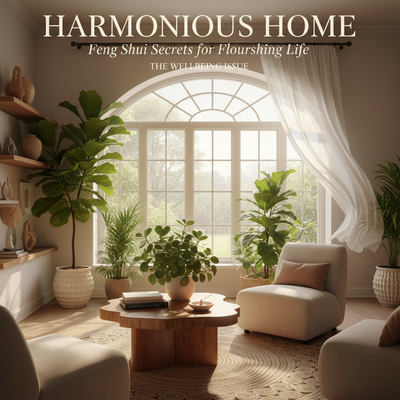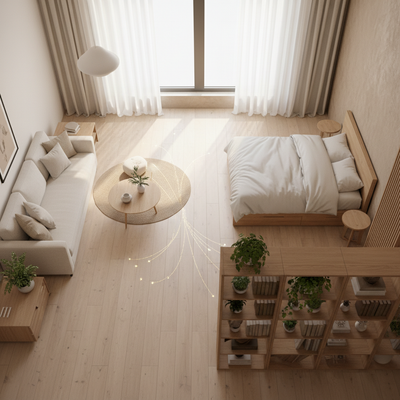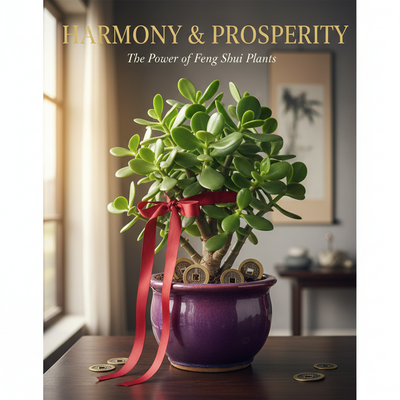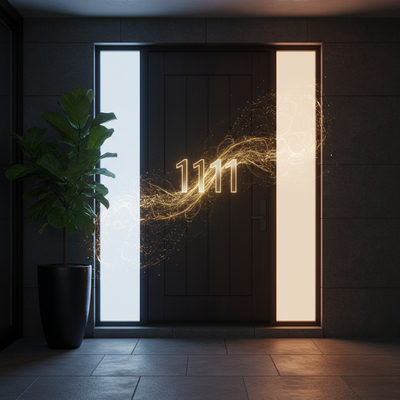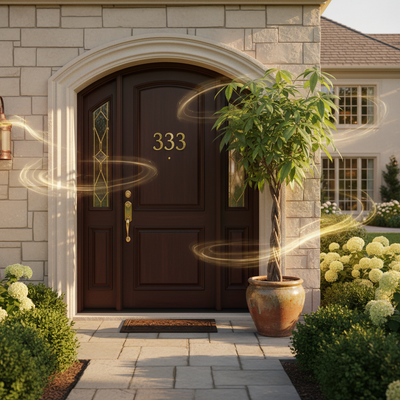Feng Shui is the practice of organizing your living space, and Chi is the life energy that moves through it. Simply put, you cannot use Feng Shui effectively without understanding and working with Chi. Learning this basic connection is the secret to creating a space that feels helpful, balanced, and full of life - a home that supports your health instead of quietly draining your energy.
This guide will teach you more than just basic definitions. You will learn what Chi really is, how to see its movement in your own home, and the practical steps you can take to fix, improve, and build it up. By the end, you will have a new way to look at your living space and a clear plan for turning your home into a place of good energy.
Learning the Basics

To really practice Feng Shui, we must first understand the energy it works with. This section explains Chi and its direct connection to Feng Shui principles.
What is Chi
Chi, also spelled Qi, is a basic idea in many Eastern philosophies. It represents the universal life force, the invisible energy that gives life to all living things. Think of it like the current in a river, the electricity powering a city, or the breath in your lungs. It is always moving, and its quality can be positive and helpful or negative and draining. Chi exists in everything - people, animals, plants, and the spaces we live in. It comes from Traditional Chinese Medicine, where balanced and freely flowing Chi in the body is seen as necessary for health. The same idea applies to our homes.
Feng Shui: Directing Chi
The words Feng Shui literally mean "wind" and "water." These are the two main natural forces that carry and spread Chi across the earth. Feng Shui, therefore, is the practice of studying and adjusting the flow of this energy within a specific space. It gives us a set of powerful principles and tools to make sure the Chi in your home moves in a way that supports your goals, health, and happiness.
- Chi is the energy.
- Feng Shui is the practice of managing that energy.
- The Goal: To slow down fast-moving Chi, wake up stuck Chi, and fix or redirect negative Chi.
The Two Types of Chi
Not all Chi is the same. The main goal of any Feng Shui change is to build positive energy and reduce negative energy. Understanding the difference between these two types is the first step toward figuring out your own space.
Sheng Chi: The Dragon's Breath
Sheng Chi is the vibrant, life-giving energy that we want to bring into our homes. Its name brings to mind the lucky and powerful breath of the dragon in Chinese stories. This type of Chi moves gently, like a slow-moving stream, and is connected with health, wealth, opportunity, and happiness. You can feel it in spaces that are clean, brightly lit, and full of life. Examples include a welcoming entrance filled with natural light, a group of healthy, growing plants, or a gently curving path leading to your front door.
Sha Chi: The Poison Arrows
Sha Chi is the opposite: a harsh, draining, or stuck energy that can hurt our well-being. It is often called a "poison arrow" because it moves too quickly in a straight line or is created by sharp, aggressive angles. It can also show up as stagnant, dead energy in cluttered or ignored areas. Common examples of Sha Chi include the sharp corner of a wall pointing at where you sleep or sit, a long and narrow hallway that causes energy to rush, clutter blocking a doorway, or a view of a run-down building from your window.
Seeing the Difference
To make the difference clear, consider this direct comparison of their qualities and sources. This framework is important for learning to "see" the energy in your home.
| Characteristic | Sheng Chi (Positive Energy) | Sha Chi (Negative Energy) |
|---|---|---|
| Flow | Gentle, winding, slow | Fast, direct, stagnant, or blocked |
| Feeling | Vibrant, uplifting, calming, supportive | Draining, stressful, heavy, chaotic |
| Source Examples | Natural light, fresh air, healthy plants, clean spaces, water features | Sharp angles, clutter, long straight hallways, dead ends, dirt |
| Goal | Build and attract | Fix, redirect, or change |
Mapping Your Home's Energy
Now, we move from theory to practice. This section gives you a clear, step-by-step exercise to map the flow of Chi in your home. This process is the single most valuable tool you can use to understand your space. We recommend getting a pen and paper to draw a simple floor plan of your home before you begin.
Step 1: The Mouth of Chi
Your front door is called the "Mouth of Chi" because it is the main point through which energy enters your home. The quality of this entry point sets the mood for your entire space.
First, stand outside your front door. Look at the path leading to it. Is it clear, well-lit, and welcoming? This encourages Sheng Chi to enter. Or is it blocked by overgrown plants, trash cans, or clutter? This can block or damage the energy before it even arrives.
Next, open the door and step inside. What is the very first thing you see? Is it a beautiful piece of art, a view through a window, or a bright, open space? This is a positive welcome for Chi. If the first thing you see is a blank wall, a staircase pointing directly at the door, or a cluttered corner, the energy is immediately blocked or forced away. Write this down on your map.
Step 2: Follow Main Pathways
Imagine you are a gentle stream of water that has just entered through the front door. Now, walk slowly through the main pathways of your home - from the entryway into the living room, toward the kitchen, and down the main hallways.
As you move, notice the quality of the journey. Does the energy flow smoothly around furniture, or does it crash into sharp corners? Does it rush down a long, straight hallway too quickly, creating Sha Chi? Does it get trapped in awkward corners or behind large pieces of furniture? Pay attention to how your body feels as you move through the space. Do some areas feel lighter and more open, while others feel heavy or cramped? These physical feelings are your intuition picking up on the quality of the Chi.
Step 3: Find Stagnant Pools
Energy, like water, needs to move around. Areas where it gets stuck become "pools" of stagnant Chi, which can lead to feelings of being stuck in life, tiredness, and a lack of opportunity. Actively look for these spots, as they are often in overlooked areas.
Here is a checklist of common stagnant Chi spots:
- The corners behind doors that are usually left open.
- The space underneath beds, especially if it's used for storing clutter.
- The dark, unused backs of closets.
- Guest rooms or other spaces that are rarely used.
- Any area piled with clutter, especially "to-do" piles of mail, projects, or laundry.
Step 4: Draw Your Chi Map
Now, take your simple floor plan and bring your observations to life. Use gentle, wavy arrows to show where you felt a smooth, positive flow (Sheng Chi). Use sharp, straight arrows to mark "poison arrows" from corners or long hallways (Sha Chi). Draw circles or shaded areas to mark the pools of stagnant Chi you found.

Congratulations. You have just created a personal tool for understanding your home's energy. This map is your blueprint for applying the solutions in the next section.
Building Good Chi
With your Chi map in hand, you are now ready to make targeted improvements. These five essential Feng Shui principles are the foundation for transforming your home's energy. For each principle, we will explain the "why" behind it - how it directly impacts the flow of Chi.
1. The Commanding Position
The commanding position is one of the most important principles in Form School Feng Shui. It says that you should position your most important pieces of furniture - your bed (representing you), your desk (your career), and your stove (your wealth/nourishment) - so that you can see the door to the room without being directly in line with it.
The Chi Connection: When your back is to the door, you are in a vulnerable position. This creates a low-level, unconscious stress (a form of Sha Chi) because you cannot see who or what might be entering your space. Placing yourself in the commanding position removes this vulnerability, putting you in symbolic control of your life and the energy that comes your way.
2. Clearing Clutter for Chi
The principle is simple: remove anything you do not use, love, or need. This is the most common Feng Shui advice for a reason - it works incredibly well.
The Chi Connection: Clutter is more than just a physical blockage; it is an energetic one. It causes Chi to become stuck, creating a heavy, stagnant feeling in both the space and its people. Every broken item, pile of old mail, or unworn piece of clothing holds onto old, stagnant energy. Clearing clutter is like removing a dam, allowing fresh, vibrant Sheng Chi to flow freely through your home and your life once more.
- Helpful Tips: Start small with a single drawer or shelf to avoid feeling overwhelmed. Use a "one in, one out" rule for new purchases. Make a commitment to fix or throw away any broken items, as they represent broken energy.
3. Light and Fresh Air
A home that feels good is almost always one that has plenty of natural light and good air circulation. This isn't just about looks; it's an energetic necessity.
The Chi Connection: Light is a powerful form of Yang energy, which is an active, bright, and cleansing part of Chi. It clears away stagnant, heavy Yin energy and refreshes a space. Fresh air works in a similar way, physically replacing stale, used-up air (and its accompanying Chi) with new, oxygen-rich air.
- Helpful Tips: Open your windows daily, even for just 15 minutes, to allow for a complete exchange of air. Clean your windows regularly to allow the maximum amount of light to enter. Use mirrors to strategically bounce light into darker rooms or corners. In areas without natural light, use full-spectrum light bulbs to copy its beneficial effects.
4. The Five Elements
The Five Elements system - Wood, Fire, Earth, Metal, and Water - is a cornerstone of Chinese philosophy. It describes the different phases of Chi and how they interact. A balanced home contains a harmonious representation of all five.
The Chi Connection: Each element introduces a unique quality of energy. An imbalance, such as too much of one element or a complete lack of another, can make a space feel "off." For example, a room with too much Metal (minimalist, grey, and white) can feel cold and sterile, while a room with no Water element can feel rigid and lacking in flow.
* Wood represents growth and vitality (plants, green colors).
* Fire represents passion and energy (candles, red colors, bright lighting).
* Earth represents stability and grounding (ceramics, square shapes, earthy tones).
* Metal represents clarity and precision (metal objects, white/grey/metallic colors).
* Water represents flow and wisdom (mirrors, black color, flowing shapes).
5. The Bagua Map
The Bagua is an energetic map that is placed over your home's floor plan. It divides your space into nine areas, each corresponding to a different aspect of life, such as Wealth & Prosperity, Love & Relationships, and Health & Family.
The Chi Connection: The Bagua allows you to perform a very specific diagnosis. By using your Chi map along with the Bagua, you can see exactly which life area is being impacted by a poison arrow or a pool of stagnant energy. For example, if your clutter pile is in the Wealth corner, it could be energetically blocking your finances. This allows you to make targeted improvements to activate the specific type of Chi you need most.
From Theory to Change
To see how these principles come together, let's walk through a common scenario. This case study shows how an expert applies this knowledge to produce real results.
The Problem: A Stuck Office
A client feels drained, unfocused, and uninspired in their home office. The desk faces a blank wall, the door is behind their back, and a corner is piled high with old files and boxes. The lighting is dim, and the room feels heavy and unproductive.
The Expert Diagnosis
A professional consultant would immediately identify several critical Chi blockages:
* No Commanding Position: Facing the wall creates unconscious stress and limits perspective. The occupant is symbolically "facing a wall" in their career.
* Stagnant Chi: The cluttered corner is a significant pool of dead, stuck energy, directly impacting progress and creating a feeling of being overwhelmed.
* Sha Chi Exposure: With their back to the door, the occupant is energetically vulnerable to interruptions and surprises, preventing deep focus.
The Solution: A Professional Change
This is precisely the kind of challenge the team at THE QI FLOW excels at solving. Their approach combines classical principles with a modern understanding of home and work life. For a space like this, their recommendation would focus on three key actions:
"The first step is always to secure the occupant's energy. We must move them from a position of vulnerability to one of power. Only then can we address the flow and quality of the Chi in the rest of the room."
- Move the Desk: The first and most crucial change is to turn the desk. It should be placed so the occupant is facing the door diagonally, establishing the commanding position. This one change immediately restores a sense of control and security.
- Clear the Stagnation: Next, the corner clutter must be completely cleared. After it is empty and clean, an upward-growing plant (Wood element) is placed there. This not only fills the void but actively introduces the energy of growth and vitality into the space.
- Improve the Chi: To fix the dim lighting, a bright desk lamp (Fire element) is added to activate energy and passion for work. A small, strategically-angled mirror might be placed on the wall to widen the space and energetically "pull" more light and opportunity in from the doorway.
The result is a complete transformation. The Chi now flows smoothly around the occupant, who feels supported and in control. The space feels lighter, and productivity and well-being are restored.
Quick Fixes for Problems
Based on your Chi map, you may have identified some common problems. Here is a quick-reference guide for easy solutions you can use right away.
- Problem: Long, narrow hallway ("Sha Chi" highway).
- Solution: Slow the Chi down with a runner rug, hang a series of art pieces along the walls to encourage the eye to wander, or place a round table in the middle if space allows.
- Problem: Staircase directly facing the front door (Chi rushes in and out).
- Solution: Place a beautiful, heavy object like a statue or a large plant at the bottom of the stairs to ground and anchor the energy. Alternatively, hang a multi-faceted crystal ball halfway between the door and the stairs to spread out the rushing Chi.
- Problem: Exposed beams over the bed (oppressive energy).
- Solution: If you cannot move the bed, the traditional cure is to hang two bamboo flutes from the beam with the mouthpieces pointing up. This symbolically lifts the oppressive weight.
- Problem: Back of a sofa floating in the middle of a large room (lack of support).
- Solution: Place a solid console table or a row of tall, healthy plants behind the sofa. This creates a symbolic "mountain" of support at your back.
Your Home, Your Partner
You now understand the basic truth of this practice: Feng Shui is the way we consciously guide and build Chi. Your home is not a static collection of walls and furniture; it is a dynamic energy system, a living partner in your well-being.
By learning to see the flow of energy, you have gained the power to shape it. Begin with one small change. Clear one corner of clutter. Open your windows each morning. Move a single chair. Even these small, intentional acts can have a powerful impact on how your space feels and supports you. Start your journey today and transform your home into a true sanctuary that feeds your energy every single day.
